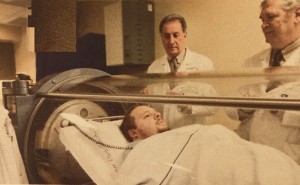
Certified Hyperbaric Physicians providing hands-on care is a critical component to hyperbaric success.
Hyperbarics: An Introduction
The practice of “hyperbaric” medicine can be traced back to 1662, when a British Clergyman named Henshaw theorized that acute diseases of all kinds would respond to changes in pressure. His pressure device, named the “Domicilium” is the earliest pressure-altering device used for medical purposes, and thus, the birthplace of hyperbaric medicine.
Of course, Henshaw’s theories were mostly inaccurate and early hypotheses, but nevertheless, the spirit of his attempt to heal remained, and for centuries physicians and scientists tinkered with the idea of changing pressure in order to aid in the practice of medicine without understanding the processes at work behind their efforts.
However, in 1955, two Europeans working separately and in different countries happened to have very similar ideas and, together, helped to birth hyperbaric medicine as it is practiced today. British physician I. Churchill-Davidson began using use high-oxygen environments hoping to reduce the effects of radiation therapy in cancer patients, and Ite Boerema of Holland proposed pressurized oxygen as a way of increasing a patient’s tolerance against circulatory arrest.
By the early 1960′s, on the heels of promise and progress by both men, a “hyperbaric revolution” had swept Europe, and soon, the United States Air Force had purchased and installed hyperbaric chambers in order to conduct research to confirm the medically sound evidence being reported across the Atlantic Ocean in North America.
Hyperbaric Medicine: Myths
Unfortunately, despite the medical potential of hyperbaric oxygen, many individuals have used the idea of hyperbarics to scam the public. These scams famously included a “hyperbaric hotel” (compressed with air rather than oxygen) in 1928, and continued through the 1986, when Pop-Icon and celebrity Michael Jackson was featured in a magazine with an accompanying headline suggesting he believed or had been convinced that hyperbaric chambers could extend his life or prevent aging. It was more likely that Jackson had been photographed in the chamber while receiving responsible medical treatment relating to his plastic surgery, but Jackson’s rebute of the article served to only further damage the reputation of hyperbarics.
Unfortunately, these myths continue even today in health spas, with “zipper chambers,” and most prominently with misleading, unfounded and unproven claims of hyperbaric oxygen therapy’s benefits. Many fraudulent hyperbaric providers claim that HBOT can help patients experiencing PTSD, or who suffer from neurological handicaps including multiple sclerosis, autism, and cerebral palsy. The unfortunate and damaging cumulative effect of these “off-label” hyperbaric fallacies on the medical community have stunted or (in rare instances) prevented the acceptance of responsible hyperbaric oxygen therapy, and have often also robbed desperate patients and families of money with unfounded offers of hope.
Hyperbaric Medicine: Establishing Credibility
In order to combat the irresponsibility of a few and decades of damaged reputation in the medical community, dedicated physicians and allied health providers joined to establish scientific credibility of hyperbarics. Through the formation of medical societies including The American College of Hyperbaric Medicine for physicians, and the more widely known Undersea and Hyperbaric Medical Society (UHMS), as well as MD and DO Specialty Board Certification pathways offered through the American Board of Preventive Medicine (ABPM) and the American Board of Emergency Medicine (ABEM) have helped to provide markers for legitimacy, responsible practice, and excellence in the field of hyperbaric medicine.
However, as important as medical certification, societies and organizations may be, they do little to combat to combat public opinion. While regulatory agencies such as the U.S. Food and Drug Administration (FDA) seek to control the “black market” of hyperbarics, and because hyperbaric medicine is so specialized, marketing, outreach, and education efforts are essential, and must be a consistent component to any community where hyperbarics are available.
Hyperbaric Medicine: Physiology
The concept of hyperbaric oxygen therapy is fairly simple: patients are enclosed in a device where atmospheric pressure can be modified using “life-sustaining” gases (usually 100% oxygen, air (containing 21% oxygen), and sometimes “nitrox” mixtures).
Once they arrive at a desired pressure (a pressure declared “therapeutic” by a physician), patients begin (or continue) breathing 100% oxygen for a designated amount of time, as indicated by their ailment. Normally (eg. at normal pressures and oxygen concentrations), oxygen is carried in the hemoglobin molecule of red blood cells (RBCs), which are transported via plasma. However,with the combination of pressure and increased oxygen concentration achieved during HBOT, additional oxygen molecules are “forced” into the plasma (“water”) portion of the bloodstream.
The additional oxygen molecules provide a variety of benefits to patients. First, the “spike” in a patient’s oxygen percentage will trigger a chemical reaction that results in the bone marrow producing “healing factors” such as fibrinogen, which help to form scabs and heal wounds. Oxygen is also able to “feed” cells that had been “hypoxic,” or oxygen starved, because it is in plasma, which is a “smaller” component of blood than RBCs. The increased capillary transport potential of oxygen allows “sleeping” cells to “wake up,” and can further add to wound healing and limb salvage. Further, anaerobic bacteria (bacteria that breed in oxygen-poor areas) are prevented from growing, and eventually even killed by the abundance of oxygen. Finally, if other molecules are present in the blood, such as nitrogen or carbon monoxide (which, if inhaled, binds to RBCs more readily than oxygen at normal pressure), are “forced” out of the blood due to “iso-baric counter diffusion” — a term used to describe the body’s natural tendency to reach molecular and chemical equilibrium or balance with the outside environment.
Combined, these factors make hyperbaric oxygen an outstanding adjunctive therapy in the practice of wound care, as well as an invaluable tool for emergency medicine, where patients may present with carbon monoxide poisoning, or aggressive anaerobic bacteria such as clostridal gas gangrene or necrotizing fasciitis (flesh eating disease).
Hyperbaric Medicine: Practice & Safety Considerations
Although the physiology of hyperbaric oxygen therapy may seem (to a trained physician or scientist) “simple” or “logical,” the administration of pure oxygen in high pressure environments presents both clinical and practical safety risks, many of which healthcare providers and clinicians are ill-equipped to control, monitor, or manage.
Although reimbursement guidelines exist to regulate the clinical practice of hyperbarics, including mandated physician availability, restrictions, guidelines, and time-limit requirements for “indicated treatment,” and in some circumstances facility, physician and/or registered nurse certification/credentialing, they are not universal, and apply primarily to health care facilities such as hospitals. Further, the complex safety and operational concerns of facilities fall under the joint jurisdictions of many regulatory organizations requiring entirely separate considerations.
Health care facilities and clinical practitioners should always consider the appropriate practice of clinical medicine, reimbursement criteria, mechanical engineering and PVHO regulations, fire concerns, material and facility design, building and health code regulations, FDA regulations, and changing standards of care and practice in order to operate safely and meet reimbursement qualifications.
Because meeting these complicated qualifications requires such varied expertise and highly trained staff, and because hyperbaric oxygen therapy is currently considered “adjunctive” or additional care in order to “speed up” healing or prevent limb loss, rather than “preserve life” in critical circumstances, many hospitals and physicians choose to exclude hyperbaric oxygen therapy from their healthcare provisions.
For facilities that do recognize the importance and value of HBOT, facility management companies, such as LIHS, are often chosen to help properly navigate and operate hyperbaric programs.
We encourage you to learn more about hyperbaric facility safety.
